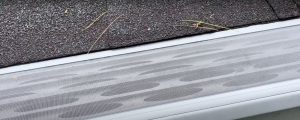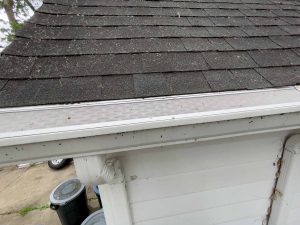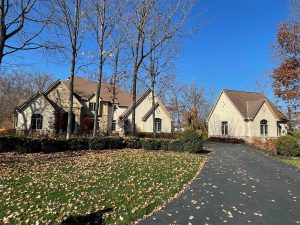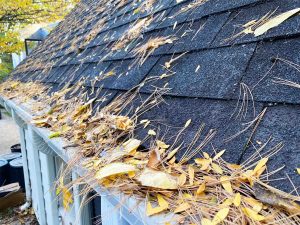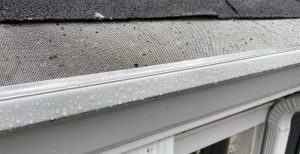Virtually all homeowners (and many commercial property owners) will be faced with the dilemma of whether or not to add gutter guards to their gutters. Unless you live in a neighborhood devoid of mature trees, you’ve likely pondered this question. That’s probably why you’re reading this blog!
Initially, there wasn’t much choice in gutter guards
Ten or 15 years ago when there were few gutter guard products on the market, homeowners options were limited to a handful of porous gutter screens and solid (reverse curve) gutter covers.
The screens were available at hardware stores and the solid gutter covers — whether incorporated into the gutter as a single piece or an add-on to an existing gutter — were available from just a handful of manufacturers, most of whom required dealers to install the gutter guards.
Store-bought gutter screens just didn’t work
It’s fairly well documented that the store bought screens don’t work, yet this was the most popular system available because the screens were inexpensive and relatively easy to install by do-it-yourselfers.
While the gutter screens help for a short period of time, they quickly collect seed pods, leaves and debris and become a breeding ground for gutter muck and tree saplings that will sprout through the gutter screen openings. [If you want your gutters to look like the rooftop of Carrabba’s Italian Grill, then this look may work for you, but the intent of gutter guards is to keep stuff out of your gutters not become an incubation place for tree saplings and mosquitoes.]
You had to remove them to clean the gutters!
In order to clean the gutters, homeowners have to remove the screens, scoop the debris from the gutters and reinstall the screens. If you have the patience for all this, you’ll likely destroy or mangle many gutter guard sections when removing and reinstalling them, so the hassle-factor outweighs the convenience and performance.
Even with a relatively modest upfront cost and several hours of your time to clean and install the screens, it doesn’t make much sense to go this route. In the end, you’ll be frustrated and looking for another solution to solve your problems.
We launched solid vinyl gutter guards on the internet
In 1997, I started a company that sold and distributed a solid vinyl gutter guard on the Web. This product is now readily available at Home Depot and Lowe’s. It is a great alternative to store-bought screens because it is solid vinyl so leaves and debris cannot easily penetrate the guards, and it deflects most debris that lands on the roof.
In fact, at the time, we believed that the solid vinyl gutter guard was every bit as effective as the pricier dealer-installed options, and is easier to deal with if you have to replace a section or eventually clean the gutters.
Great for heavy rainfall, not so good for small debris
This product features a relatively narrow opening below the curved nose with a series of slots that run horizontally along each section. This allows most water to get into the gutters, but it can be problematic in yards where trees shed small leaves, seed pods, pine needles, and “dirty”; debris can easily clog the openings.
While the openings can be power washed or cleaned manually, the combination of the small openings and the narrow slots may require regular maintenance if you have trees that produce and shed small debris.
Large debris from trees? Solid gutter cover is affordable
By contrast, if the leaves and debris from your trees are relatively large, then the solid gutter cover is an affordable solution that may meet your needs. Just keep in mind, if you go this route, invest in 1/2 inch stainless steel sheet metal screws so that you can secure the front edge of the gutter guards to the gutter lip.
This will prevent the gutter guards from blowing off in high winds. It’s also important to cap the exposed gutter ends; otherwise, birds, squirrels, and other critters will build nests inside your gutters that will not only cause clogs but other problems, too.
Dealer-installed gutter guards
The next option is dealer-installed gutter guards. Most of the gutter guards on the market are solid aluminum or vinyl and utilize a reverse curve technology. Originally patented in the early 1900s, there are several variations of these products on the market available from many manufacturers.
LeafGuard, Gutter Helmet & GutterTopper
Reverse curve systems are found under the brand names of LeafGuard, Gutter Helmet, GutterTopper and more. Each product has its own features that purport to make their system better than the next. They all use the core physical principle of “surface adhesion”; that means water will be attracted to the gutter guards surface and will follow the path of the system into the gutter. Unfortunately, this also means that any debris that gets stuck to the guards can also enter the gutters.
The openings of these systems tend to be wider than the solid gutter cover mentioned above, so you’re actually at greater risk of getting more debris in your gutters than the less expensive system, but the opening is less likely to clog. It’s also common in shady and wooded areas to see residue build-up on the surface and nose of these systems that will require occasional cleaning.
Dealer will clean your gutters if they clog
Since the products are professionally installed, most dealers claim that they will clean your gutters if they clog. Knowing that their products are subject to clogging, dealers set aside dedicated time to clean gutters. If you live in an area with a limited number of trees, or the trees are farther away from your house, then this may not be an issue, and your decision to purchase one gutter guard over another may be driven by features and/or price.
Attached to roof shingles
Another factor to keep in mind is that most of these products secure to your roof as well as the gutters. The advantage of this is that the guards maintain the same slope as your roof, but the disadvantage is that when you replace your shingles, you will have to remove these systems and reinstall them once the new roof shingles have been installed.
You’ll want to factor this into your budget as a future outlay or, if you’re looking to put on a new roof in the near future, wait to install the gutter guards until after your new roof has been installed.
Micro-screen gutter guard systems
The latest in gutter guard technology is the advent of the ‘micro-screen’; gutter protection system, which came onto the scene around 2003. Essentially a hybrid between the classic solid surface system and the store-bought gutter screens, these systems use a sturdy stainless steel weave that doesn’t allow any material to penetrate the gutter guards.
Even shingle grit (like a grain of sand), which naturally separates from asphalt shingles and falls into gutters, is too big to get through the screen.
LeafFilter, Mastershield & Gutterglove
Two of the products – LeafFilter and Mastershield – were invented by the same person, and a third micro-screen gutter guard system is manufactured by GutterGlove. What’s the difference between these products? As best we can tell, not much.
LeafFilter was the original product and, to some degree, we think it is the best because it’s the only variation that secures soley to the gutter. This will provide the best long-term fit because when you replace your shingles, the roofers will not interfere with the gutter system since it is self-contained.
The disadvantage is that the LeafFilter’s slope may be a little less than Mastershield and GutterGlove since both of those products attach under the roof shingles; however, the slope tends to changes from one end of the gutter to the other, so the overall impact of the slope differential is relatively minor.
Are micro-screen gutter guards subject to clogging, either in the gutters or on the screen?
Holes in the screens used on the micro-screen gutter guards are so small, generally only a human hair can get through them. It’s true that debris can collect on the micro-screen products as easily as it collects on the solid surface products, yet with thousands of tiny openings on the topside of the gutter, it’s more likely that water will penetrate the screen than the solid gutter cover.
And with no openings into the gutter, it’s virtually impossible for all but the most microscopic debris to enter the gutters. If your trees shed high quantities of leaves, small debris, pine and fir needles, then a micro-screen is your best solution since they’re the only products proven not to clog. These products also tend to have the most comprehensive warranties.
There are other gutter protection systems on the market beside solid gutter covers and micro-screens. Since we have not tested them or seen them in the field, we’ll reserve judgement about whether or not these products work well over an extended period of time.
Gutter guards prevent water damage from clogged gutters
There are many sound reasons to add gutter guards to your home. Clogged gutters are the #1 cause of leaking basements, drainage and foundation problems. If not addressed, leaks can cause flooding, foundation and interior damage, mold and mildew.
While some homeowners insist on cleaning their gutters when they clog, this can be costly and impractical, especially when freshly cleaned gutters can clog within hours and overflowing gutters can cause problems in between cleanings.
Homeowners can be injured trying to clean gutters
According to U.S. government issued statistics, 150,000 people are injured as a result of falling off of ladders and more than 150 people are killed annually. Whether you break a leg or wrist or sustain more serious injury, the cost of time off from work and a stay in the hospital far outweighs the investment in gutter guards that will ultimately provide you with more free time and enhance the resale value of your home.
I recently met a man who fell off a ladder when cleaning his gutters. The day I met with him, his jaw was wired shut and he had two steel rods protruding out of his arm that connected to a third rod that was helping to fuse the bone in his arm together. While he is lucky to be alive, he told me that his hospital and doctors bills exceeded $500,000!
So, which gutter guard will you choose?
Today, you have many options from which to choose. The quantity and types of trees in your yard, your roof’s slope, roof type (shingle, tile, metal, etc.), and the types of trees and proximity to your home will determine the application that is best for you.
Price will undoubtedly play a factor, too. With so many products on the market, we encourage you do your homework by comparing the reverse curve and micro-screen systems, ask to view the manufacturers’ warranties, and then select the solution that is best for you.


